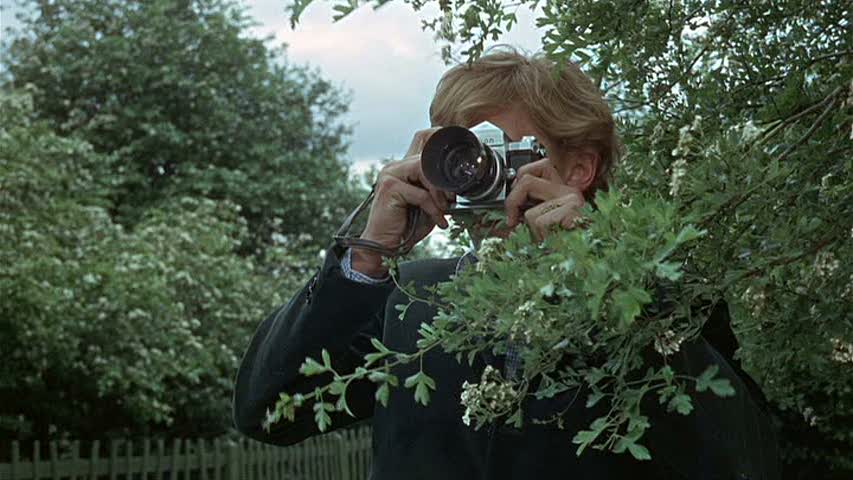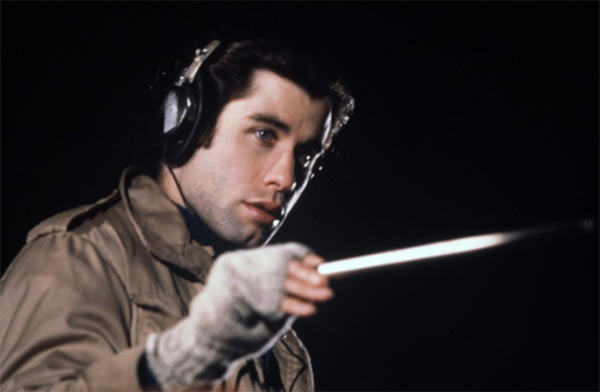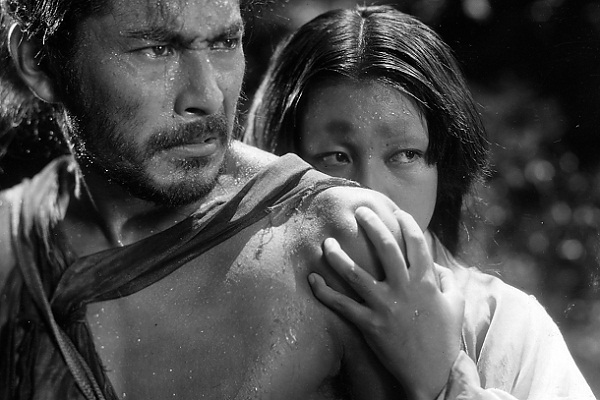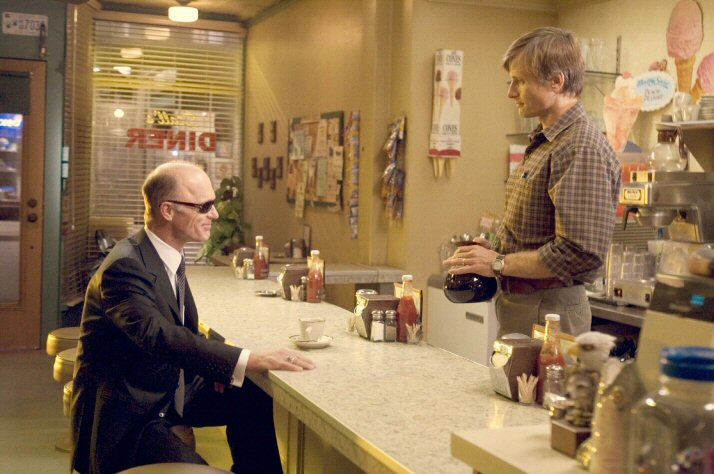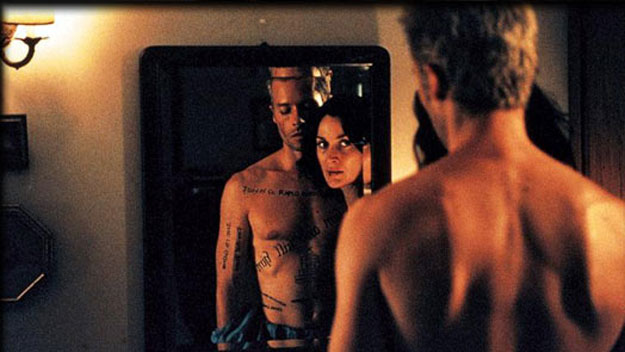Film is a very perceptive medium. It utilizes more senses in recording and communicating than others and thus it perceives more. Yet this also makes cinema the most deceptive of mediums. Its artifice is cloaked in pretensions of authenticity. Its range of perceptions, its imerssiveness, leaves its audience with tremendous blind spots. This qualifies film to investigate the limits and nature of perception better than any other art form.
Film can shape what we see, hear, and feel in a variety of ways. And since our basic relationship to it is one of credulity, wanting to buy into its artifice for the sake of entertainment, it can loop back on its self, make suggestions, play games and tricks, fool and tease us in more ways than photography, painting, theater, radio, or music. Movies fold all of the above into a single experience and, taking our investment in its reality as a given, if a film so chooses it can call perception its self into question and make reality seem unstable.
The most common way films do this is by calling their own methods into question. In films like Antonioni’s Blow Up and De Palma’s Blow Out we are treated to films that contemplate the medium itself: its moral implications and perceptual limitations. Whereas films like David Cronenberg’s A History of Violence brings in a self-conscious meta-narrative regarding genre conventions and what happens when one kind of reality intrudes upon another. What you get are competing sets of perception.
Film is our broadest and most perceptually inclusive art form. At its most considerate and perceptive it cannot help considering itself. A medium based so elementally on approximating the collective human experience will inevitably aspire to untangle the mysteries of perception, though as these films show, it often ends up pulling at the threads of its own construction.
1. Blow Up – Michelangelo Antonioni (1966)
Michelangelo Antonioni’s Blow Up was a totem for the swinging 60’s. It captured a moment and a mood among young people at the height of the west’s Cultural Revolution and gave them an ideal of style and cool that was also beautiful and strange. Antonioni was an acute observer of moods. His eye for sadness, ennui, and malaise tested the facets of cinema. A medium bred for intensity and motion was in his hands elegiac and circumspect.
The story of Blow Up concerns a London fashion photographer named Thomas who has lost his zest for his charmed life. He lolls through his work and his play with a disaffected boredom one could rightly describe as Antonioni-esque. One day while photographing in a park he takes images of a couple as they embrace and kiss. The woman notices him and becomes agitated. She demands the photos. He refuses at first but says she can have them after he has developed them. We learn he wants them for a book he is planning featuring candid portraits.
Everything to this point has been a lead up, a description of the character. It is only once he begins developing the pictures from the park that the photographer comes alive. In his Great Movies on Blow Up Roger Ebert described the effect of this sequence as the character being, “…awakened briefly from a deep sleep of bored alienation.” “[H]is mind, his hands, and imagination work in rhythmic sync. He is happy.” The sequence in which the character develops the pictures and, through a series of blowups (thus the title) realizes he may have photographed a murder is a rapid and energized series of visual revelations.
In the park, in the moment, Thomas only perceived the intimate play of the couple. Now, with the help of photographic technology, this one moment balloons out into something sinister. But the effect and focus of the developing sequence, once the film has settled and you perhaps re-watch Blow Up, or even better view it in context with the rest of Antonioni’s career, is more of process than of plot.
The central fact of a photographer becoming stimulated by reality through his craft, a craft that allows him to enlarge and manipulate perception, reveals as much about Antonioni as his character. Because not only is Thomas, the photographer, in a rapture of craft, so is Antonioni.
In a career of open-ended stories, subtle misdirections, and sternly unanswered questions, the developing sequence in Blow Up is Antonioni at his most involved, open, and engaged. It is not hard to nominate those minutes in the middle of Blow Up as the best of his career. To paraphrase Ebert, he seems awakened, in rhythmic sync, happy.
2. Blow Out – Brian De Palma (1981)
Brian De Palma’s Blow Out is a movie about moviedom like very few others. It’s not hard to see why Quentin Tarantino cites it as one of his very favorites. Tarantino who once had a movie within his movie declare it would kill its audience just before a character lit a pile of nitrate film stock behind the screen, making unsubtle statement of Tarantino’s basic philosophy about film: it should be a bomb thrown into the audience, obviously.
De Palma’s film is less didactic but no less self-aware. It opens on a sequence of a film that the characters are making which is so overtly cinematic it can only be read as a wink at the audience. This sequence features a concentrated tableau of puerile misogynistic imagery the like of which most schlock filmmakers could only dream of constructing.
When one saw the graphically suggestive posters on grindhouse marquis and video boxes in rental shops, this movie within the movie is what most imagined. Though these films tended to be tamed by their terminal badness, lacking the imagination or technical skill to be genuinely shocking. De Palma teases us with this opening sequence making us wonder, just for an instant, if he might not actually be that kind of film maker.
But after a few minutes we are jarred out of this schlock horror picture and into the actual narrative space of Blow Out. It is about a sound designer played by John Travolta who, at the request of the director of the film within the film, goes out one night to record new wind effects. He stands on a bridge and we hear what he hears. He records wind, lovers talking, and a frog croaking in the distance. Then he hears a car approaching. He turns his microphone in that direction. He hears a bang, a tire blow-out, and sees the car crash into the lake.
Like Blow Up, Blow Out takes an incident recorded by an element of cinematic technology and places it at the center of its story. But unlike Blow Up, De Palma’s movie is far too excited by the possibilities for action and lively cinematic formula to get bogged down in his character’s ennui or awakening therefrom. For De Palma, even when deconstructing the process of cinema and the levels and dimensions of perception it both enables and obscures, cinema can only be an excuse for more cinema.
The recording leads to a murder plot, a political conspiracy, and a spectacular chase scene. Blow Up is a movie about moviedom and its obsessions. It is a happy slave to formula and even celebrates its own plot holes.
Travolta’s character sends his love interest off with the killer when there was absolutely no reason to do so, and then has to chase after them through a celebratory parade. The movie seems to be exalting in this absurdity with bells, bands, and fireworks. Blow Out is a movie about the glory of cinema’s blind spots, of its power to erase logic and trick the audience.
3. Rashomon – Akira Kurosawa (1950)
Akira Kurosawa’s early masterpiece Rashomon has what can be described as a varicose plot. It has a central story structure from which branch numerous tangential accountings of events. It is a device that has been appropriated and simplified into a stock comedic trope. Nearly every television sit com that runs for more then two years will eventually do its own version of the Rashomon plot.
It is the story of three men hiding from a rainstorm. Two of them have just come from a trial whose incident and result has left them both deeply shaken. They tell the story of the trial to the third man who is a cynical and disillusioned individual. During the trial the story of a rape and murder are told from three different perspectives, that of the bandit, the rape victim, and the ghost of the murdered man with the help of a medium.
All versions differ in nearly every detail but each is terrible in its own particular way, revealing nearly infinite possible weaknesses and transgressions among the participants. Each interpretation presents evils done and suggested beyond the facts of the crime and whatever the truth is, someone must be lying and their motivations cut to the heart of even more complexities and questions.
In his introduction to the Criterion edition DVD Robert Altman speaks of the way movies create a reality we instinctively buy into as result of its imerssiveness. He goes on to suggest that Rashomon’s great innovation was to confront us with an indeterminate plot, multiple stories that end the same, not allowing us the comfort of a clearly defined narrative reality.
When lazier hands take up this plot device it becomes about differences in interpretation, comic variations conforming to basically the same events, suggesting that truth is constant and is merely colored by perception. Rashomon aims higher and presents a vision of truth that is far less stable. For Kurosawa’s film truth is fleeting and perception is subject to the inscrutable motivations and manifold limitations of humanity.
4. A History of Violence – David Cronenberg (2005)
David Cronenberg has very often concerned himself with the way perception is subject to forces like electronic media (Videodrome, ExistenZ), chemical imbalance and narrative concepts (Naked Lunch), deviant sexuality (Crash), and perceived identity (Dead Ringers). But more so than in earlier films his 2004 movie A History of Violence considers how perceptions within movies, determined by genre expectations and formulae, shape characters themselves.
The movie takes place in an insular idealized small town in Indiana. The main character is Tom Stall, played by Viggo Mortenson as taciturn and humble Tom owns a diner in town and is married to a local lawyer with whom he has two children. Any number of family dramas or coming of age films might be set around Tom’s family in their small town in Indiana. But into his diner come two killers who threaten Tom’s customers and friends.
Up to this point the perception of Tom within the film is that he is just like everyone else, strong and quiet but normal. To read the genre expectations of a family drama set in a small town wherein a main character is being held at gunpoint we might expect he will survive and suffer guilt. His family will rally around him as his son finds love and self worth in a concurrent B-plot.
But Tom is an interloper from a different genre with different expectations. He smashes one killer in the face with a coffee pot, leaps of the counter, retrieves the gun the injured man dropped and shoots both men dead. It is a fast and brutal scene handled with typical Cronenberg grit and visceral detail.
Tom is praised as a hero, his image is broadcast on television and soon men come looking for him. They call him Joey and intimate a dark hidden past.
Who is Tom?
Tom is a family man.
Joey was a ruthless killer.
Is Tom Joey?
What makes the difference?
These facts and questions make up the story of A History of Violence, but at a very basic structural level what we have is a gangster film that ended twenty years before this film began and this film is what happens when genres collide. Expectations and reality combine to create dissonance and characters are forced to confront themselves and each other without the comfort of their expectations as an easy guide.
This is the unique sight a film playing within the limits of perception as defined by cinematic convention testing where they might overlap and seeing weather or not they will break.
5. Memento – Christopher Nolan (2000)
Of all the films on this list Christopher Nolan’s career making hit Memento does the most to ostentatiously toy with cinematic perception. It is told backward from the perspective of a character that cannot form short-term memories. He operates by means of Polaroid pictures, notes left for himself, and tattoos left on his body. As seen in Memento perception is actually a mess of fragments placed into a largely artificial order so that we may confidently act upon them.
Movies build story in a very predictable way, elements arise in a linear fashion and conflict occurs based on a clear understanding of the characters’ motivations. Memento scrambles this formula so that the larger motivation (the murder of the main character’s wife) is constant but the incitement to each act and instance remains unknown until the next (sequentially previous) scene.
Thus we are encouraged to explicitly contemplate perception as an element of the story. What we know, what the characters know, what truth is being uncovered or obscured, and how long any of it will persist makes the specter of perception a constant presence in Memento.

